

![]()
RICHARD ANSDELL, R.A.
1815 - 1885
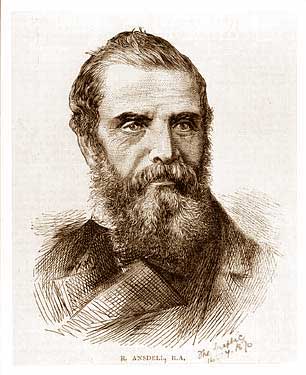
Many thanks go to Anna Nelson for the original article
which first appeared in the Shepherd's Dogge magazine, Spring 1992;
additional text is by Carole L. Presberg and Sarah Kellam.
I am extremely grateful to Sarah Kellam of Somerset, England, for her generosity.
Most of the paintings reproduced on this webpage were copied and sent to us by her,
including this portrait of her great-great-grandfather, Richard Ansdell, above.
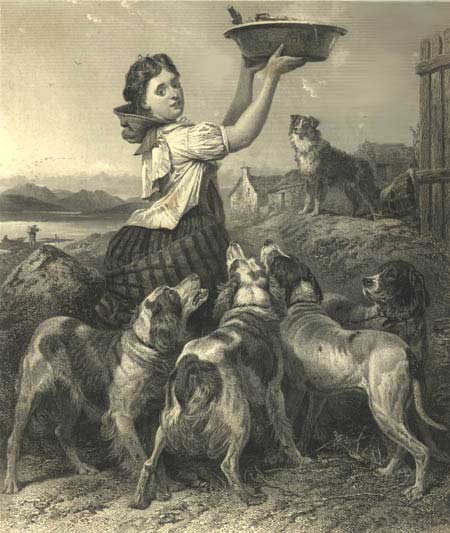
"The Highland Keeper's Daughter"
In this engraving by our featured artist, we see a young girl coming to feed hunting dogs, with a steaming pan of bones presumably from a deer recently slain by the hunting party of the aristocrat who owns the Highland estate where the girl's father, the keeper, is employed. In the background, a shepherd's dog looks longingly at the feast. He is free, unlike the hunting dogs, who are chained, but his fare will undoubtedly be a share of his master's more modest meal of oatmeal rather than a portion of the hunding dogs' more attractive meal. There is another version of "The Highland Keeper's Daughter" that does not include the shepherd's dog.
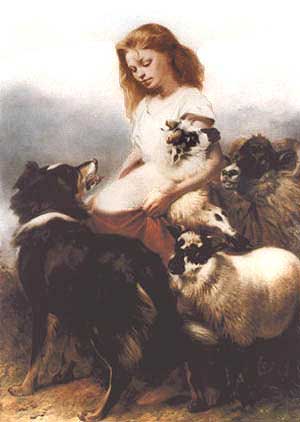
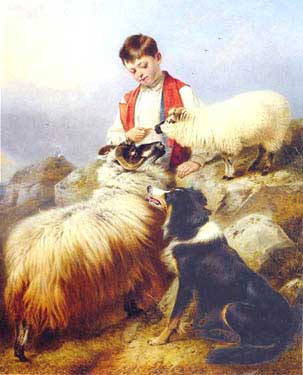 Richard Ansdell was born in Liverpool in May 1815, and lived in his hometown until the late 1840s. At that time, Liverpool was a flourishing centre for art. The most remarkable thing about Ansdell was that he did not become seriously interested in art until he was 21 years old. In 1837 he was elected to the Liverpool Academy, and exhibited two works at the Royal Academy in London in 1840. The Liverpool Academy elected him president in 1845. Although he was so closely connected with Liverpool, his work was always very different from the then-current artists of that city.
Richard Ansdell was born in Liverpool in May 1815, and lived in his hometown until the late 1840s. At that time, Liverpool was a flourishing centre for art. The most remarkable thing about Ansdell was that he did not become seriously interested in art until he was 21 years old. In 1837 he was elected to the Liverpool Academy, and exhibited two works at the Royal Academy in London in 1840. The Liverpool Academy elected him president in 1845. Although he was so closely connected with Liverpool, his work was always very different from the then-current artists of that city.
His most famous work, "The Battle of the Standard", was exhibited at the Royal Academy in 1848. Its popularity encourged him to move to London. He lived in Kensington, as did most artists of the day, and often collaborated with other artists. Twice he travelled to Spain, and on returning painted many scenes he had sketched white there. These were to become some of his most cherished works. Ansdell was especially popular in the north of England, and frequently exhibited in Manchester, then, like Liverpool, a city known for art patronage.
The painting above left is called "The Herd Lassie" and was painted in 1874; above right is "Spring in the Highlands" painted in 1877.
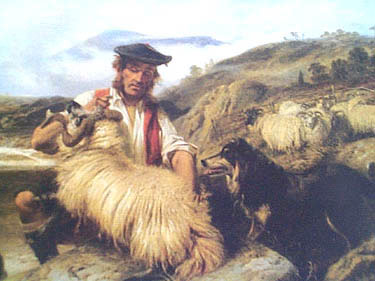 Proof of his popularity is given by his biographer, Arthur Todd, who says that after Ansdell moved to Lythan in North Lancashire in 1861, first a road, then a railway, and then an entire district of the county came to be known as "Ansdell". Sadly for the locals, he later moved to Hampshire, and had a summer home on Loch Laggan in Inverness-shire in Scotland. The painting at left is called "Dipping the Sheep". The collie in this painting is of a color rarely seen anymore in Border Collies, but common in English Shepherds, black-and-tan.
Proof of his popularity is given by his biographer, Arthur Todd, who says that after Ansdell moved to Lythan in North Lancashire in 1861, first a road, then a railway, and then an entire district of the county came to be known as "Ansdell". Sadly for the locals, he later moved to Hampshire, and had a summer home on Loch Laggan in Inverness-shire in Scotland. The painting at left is called "Dipping the Sheep". The collie in this painting is of a color rarely seen anymore in Border Collies, but common in English Shepherds, black-and-tan.
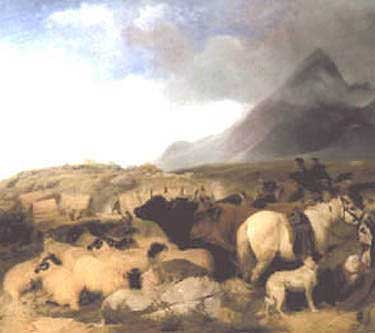 Like many Victorians, including Queen Victoria herself, Ansdell loved the Highlands and often painted Landseer-esque scenes of drovers and shepherds, some of which feature working collies. Two of these, very similar to one another, are "The Drover's Halt, Island of Mull in the Distance" and "The Drover's Halt", one of which (it is not known which) was included in Ansdell"s first British Institution exhibit in 1846. The example at left is a detail of the painting called "Sheep Gathering in Glen Sligachan". Painted in 1854, it shows drovers and their flocks bedding down for the night after the gathering in a glen on the Isle of Skye. It is interesting to note that one of their dogs, near the pony in the right foreground of the painting, is an all white dog with a tricolored head. There are other dogs in the painting but one has to look really hard to spot them. This is a magnificent painting which recently sold at auction with an asking price of 200,000 - 300,000 pounds sterling, showing that Ansdell is considered by some to be one of the foremost Victorian artists.
Like many Victorians, including Queen Victoria herself, Ansdell loved the Highlands and often painted Landseer-esque scenes of drovers and shepherds, some of which feature working collies. Two of these, very similar to one another, are "The Drover's Halt, Island of Mull in the Distance" and "The Drover's Halt", one of which (it is not known which) was included in Ansdell"s first British Institution exhibit in 1846. The example at left is a detail of the painting called "Sheep Gathering in Glen Sligachan". Painted in 1854, it shows drovers and their flocks bedding down for the night after the gathering in a glen on the Isle of Skye. It is interesting to note that one of their dogs, near the pony in the right foreground of the painting, is an all white dog with a tricolored head. There are other dogs in the painting but one has to look really hard to spot them. This is a magnificent painting which recently sold at auction with an asking price of 200,000 - 300,000 pounds sterling, showing that Ansdell is considered by some to be one of the foremost Victorian artists.
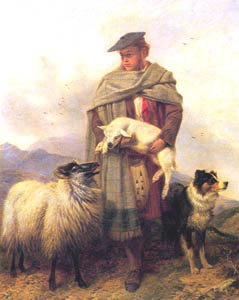 "The Good Shepherd", left, painted in 1870, shows a shepherd on the hills, in his kilt, plaid and bonnet, carrying a lamb whose anxious blackface mother bleats for it. Beside him stands his tri-colored collie, typically marked. This painting appeared on the cover of the October 26, 1983 edition of The Field, a British magazine, and was kindly sent to us by Barbara Carpenter of Gloucestershire, England. It had been erroneously attributed to Landseer, but thanks to Sarah Kellam, we now have it attributed to the correct artists, Richard Ansdell, R.A.
"The Good Shepherd", left, painted in 1870, shows a shepherd on the hills, in his kilt, plaid and bonnet, carrying a lamb whose anxious blackface mother bleats for it. Beside him stands his tri-colored collie, typically marked. This painting appeared on the cover of the October 26, 1983 edition of The Field, a British magazine, and was kindly sent to us by Barbara Carpenter of Gloucestershire, England. It had been erroneously attributed to Landseer, but thanks to Sarah Kellam, we now have it attributed to the correct artists, Richard Ansdell, R.A.
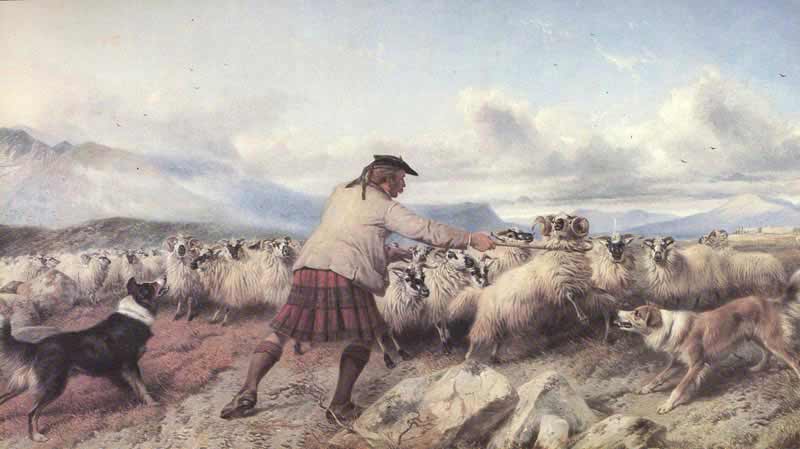
Two other paintings of droving scenes were both called "Turning the Drove". Ansdell was awarded a gold medal at the International Exhibition in Paris in 1855 for the one above which features two gorgeous collies, a tricolored one on the left and a beautiful sable on the right. This painting was chosen a few years ago by the International Sheepdog Society for its Christmas card. The other of the same name (not pictured here) was painted a few years earlier in 1851. Ansdell often recycled titles for his paintings of a similar subject. Another painting chosen by the ISDS in recent years for its Christmas card, "Sheep Washing in Glen Lyon" (not pictured here), shows a drover or shepherd being assisted by a large, fierce-looking tricolored collie.
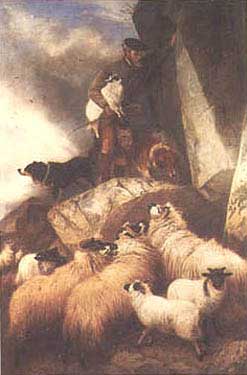
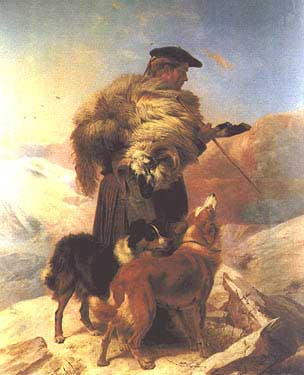
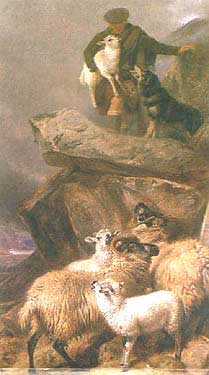
A much repeated theme in Ansdell's Scottish paintings was the concept of the shepherd rescuing a stray lamb, and there are several paintings called "The Rescue". Often, these showed lambs separated from their mothers and being rescued off of rock faces and cliffs, but others showed newborn lambs being rescued from seagulls. Lambing in isolation on the hills of Scotland, would often be perilous for both ewe and lamb. Foxes, eagles, and wildcats were quite capable of carrying off a newborn lamb, and sea gulls often swooped in to gobble up the afterbirth or pluck out a lamb's eyes.
The three paintings, above, are all called "The Rescue". Sarah Kellam, says that Ansdell owned collies and often used them as models for the dogs in his paintings. The black dogs in these paintings are tricolored, and the "red" dogs are probably actually sable or a deep reddish tan, since their nose leathers look black. We must assume that these were dogs he was familiar with and that he used as models. There are probably other paintings by Ansdell that share the same name. The one at the left was selected by Iris Combe for the cover of her book Herding Dogs (Faber and Faber, 1987). It shows a shepherd carrying a lamb down from a ledge to the waiting flock, below, accompanied by two collies.
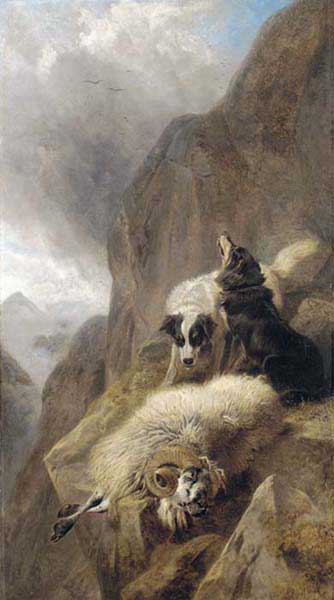
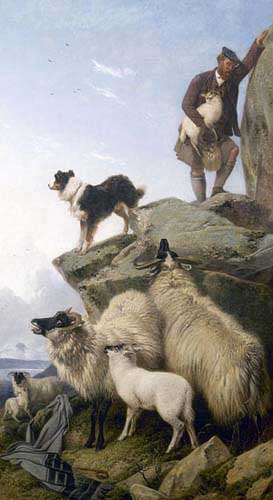 These two paintings, "Stray Lamb", right, and "Stricken Sheep", left, are related in theme to the three paintings called "The Rescue".
These two paintings, "Stray Lamb", right, and "Stricken Sheep", left, are related in theme to the three paintings called "The Rescue".
The one on the left is very dramatic, with the mist and clouds descending, the seagulls beginning to arrive, and the sheep lying precariously over the edge of the cliff. One dog (the patterned white from previous paintings) watches over the sheep, and the other (the black-and-tan, also seen in other of Ansdell's paintings) alerting the shepherd to where he can find them. The dogs seem to be showing concern for the sick sheep. I've found that to be the case with my own Border Collies--they appear to "worry" about a sick animals.
In the painting at right, the feeling of the scene is very different. The day is clear and the dog (another we have seen before, a tricolor) appears rather indifferent, as if this were all in a day's work. In fact, there are some peculiarities in this painting. Look to the bottom left corner. The shepherd has left his crook and plaid on the rocks below, but they seem oddly flat and out of proportion, as if the artist left them there meaning to go back for them, but forgot about them in painting the details in the rest of the picture.
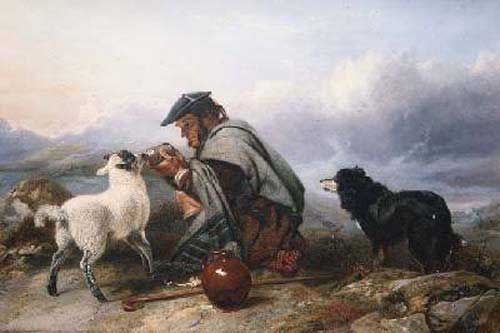 This one is either called "The Sick Lamb" or "The Orphaned Lamb", and shows a shepherd bottle-feeding a lamb. The dog in the painting is the black-and-tan. Ansdell often used the same dogs over and over, and one theory is that these were his own dogs. The same people (shepherds, keepers, etc.) also seem to appear over and over in his paintings.
This one is either called "The Sick Lamb" or "The Orphaned Lamb", and shows a shepherd bottle-feeding a lamb. The dog in the painting is the black-and-tan. Ansdell often used the same dogs over and over, and one theory is that these were his own dogs. The same people (shepherds, keepers, etc.) also seem to appear over and over in his paintings.
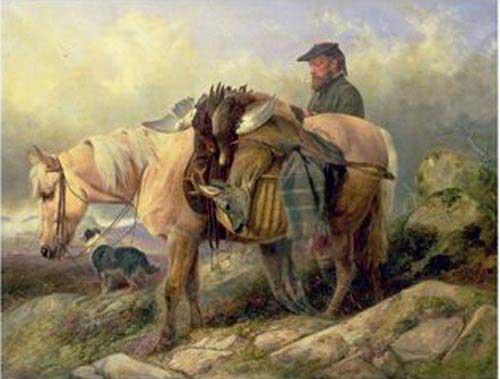 "Returning from the Hills" shows a shepherd or gamekeepter, returning from a day's hunting in the hills. Across his Highland Pony's saddle is the kill of the day, a deer and a couple of fowl. His dog is also in the picture, and it shows how versatile these dogs could be, for it is a tri-colored sheepdog. Often a shepherd would have trained his dog to hunt as well as herd. This practice extended into modern times, for H. Glyn Jones, the famous Welsh trialist and trainer, says in his book A Way of Life, Sheepdog Training Handling and Trialling (1987 Farming Press Ltd.), that "Every sheepdog that my father trained for trials was also taught to retrieve--an ability which was put to good use during shooting days on the estate; and because he trained dogs for poachers as well as sheepdog handlers, he was well patronised, both kinds of dog being in great demand. Surprisingly, as far as I can remember, being taught to retrieve did not seem to interfere with a sheepdog's ability to work with sheep when required to do so."
"Returning from the Hills" shows a shepherd or gamekeepter, returning from a day's hunting in the hills. Across his Highland Pony's saddle is the kill of the day, a deer and a couple of fowl. His dog is also in the picture, and it shows how versatile these dogs could be, for it is a tri-colored sheepdog. Often a shepherd would have trained his dog to hunt as well as herd. This practice extended into modern times, for H. Glyn Jones, the famous Welsh trialist and trainer, says in his book A Way of Life, Sheepdog Training Handling and Trialling (1987 Farming Press Ltd.), that "Every sheepdog that my father trained for trials was also taught to retrieve--an ability which was put to good use during shooting days on the estate; and because he trained dogs for poachers as well as sheepdog handlers, he was well patronised, both kinds of dog being in great demand. Surprisingly, as far as I can remember, being taught to retrieve did not seem to interfere with a sheepdog's ability to work with sheep when required to do so."
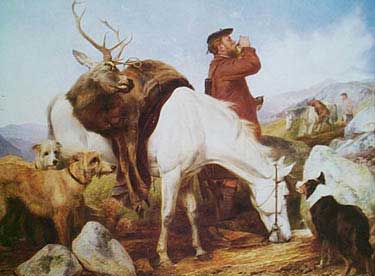 Some of Ansdell's Highland scenes contain sheepdogs, but others are of other aspects of Highland life than shepherding. His paintings portray a rich tapestry of life in the Highlands of Scotland, for which Richard Ansdell was a master. A large, generous man, Ansdell was fond of country pursuits, and sometimes painted the shooting parties he enjoyed. The painting at left is called "The Deer Hunt", and shows a tricolored collie on the right and two deer hounds on the left. When these shooting parties went out, everyone on the estate would go along, including the shepherd, the keeper, and probably the gardener as well! The "lower classes" would act as "beaters". They went before the dogs and beat the brush with sticks to flush out the game.
Some of Ansdell's Highland scenes contain sheepdogs, but others are of other aspects of Highland life than shepherding. His paintings portray a rich tapestry of life in the Highlands of Scotland, for which Richard Ansdell was a master. A large, generous man, Ansdell was fond of country pursuits, and sometimes painted the shooting parties he enjoyed. The painting at left is called "The Deer Hunt", and shows a tricolored collie on the right and two deer hounds on the left. When these shooting parties went out, everyone on the estate would go along, including the shepherd, the keeper, and probably the gardener as well! The "lower classes" would act as "beaters". They went before the dogs and beat the brush with sticks to flush out the game.
Not surprisingly, Ansdell was able to find friends and patrons in aristocratic circles quite early in his career. Most of his paintings are striking and on a large scale, and usually of subjects that would have appealed to those with a Royal Academy turn of mind. It was said that he was adept at composition, though not a very good colorist, and he lacked the necessary "finish" to be considered great. Some thought that he did not seem to have Landseer's heart-felt understanding of animals. Still, others said he was influenced by and rivaled Landseer in the variety of his subject-matter and detail of his paintings, but that he lacked Landseer's taste for the sentimental and dramatic, though, the next painting proves otherwise.
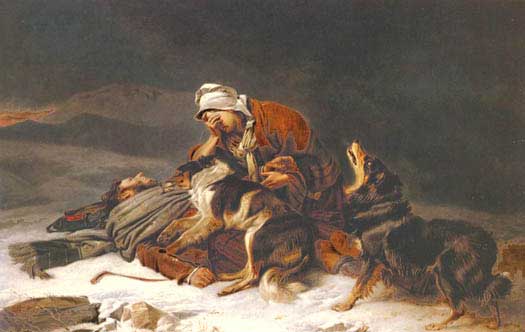
This magnificent painting is called "Lost In The Storm". It shows a man in a kilt and shepherd's plaid, presumably dead from exposure and found by his wife. Two collies mourn over him, the "usual" black and tan we see over and over in Ansdell's paintings, and an unusual patterned white collie. If one were to imagine the "back story" on this painting, perhaps the smaller collie stayed with her fallen master while the larger one went for help, but it was too late.
THE OTHER WEB PAGES WE MAINTAIN
These web pages are copyright ©2013
and maintained by webmeistress Carole Presberg
with technical help from webwizard David Presberg
ALL RIGHTS RESERVED
If you are interested in using ANY material on this website, you MUST first ask for permission.